World War One: German ships took war to England's doorstep
- Published
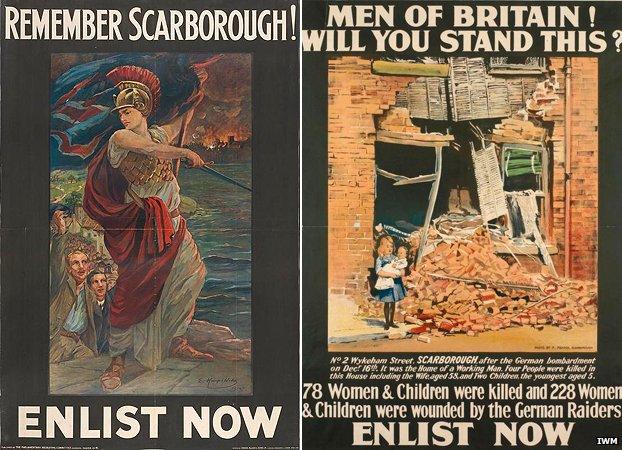
For 120 years, war had happened somewhere else - but on 16 December 1914, the Germans brought it to Britain's doorstep.
On that foggy morning, six steel-clad warships of the Imperial German Navy slid into view off the north-east coast of England.
Huge naval guns swung to face the awakening towns of Scarborough and Hartlepool and, just after 08:00, they fired.
World War One would claim not just soldiers, but neighbours too.
Scarborough was hit first. The undefended town's population was stunned as shells, designed to crack armoured battleships, slammed into buildings.
At 2 Wykeham Street, the Bennett family had been getting ready for the day.
In an account to the Scarborough Mercury, 25-year-old Christopher Bennett said: "Father and mother and the two children were downstairs in the kitchen, and father had called out to me: 'Come on lad. Let's away downstairs. It's the Germans. Come and look after mother.'
"But, before I had time to get downstairs it had all happened.
"It was a long time before I realised anything or where I was. I was practically buried in stuff.
"When at last I could look around me I had only a shirt and one slipper on."
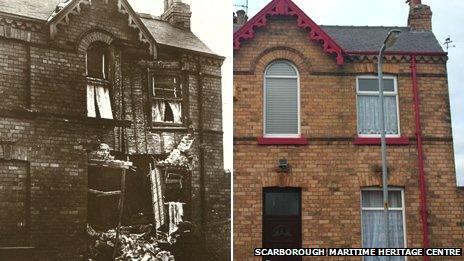
2 Wykeham Street was rebuilt and looks much the same today as before the attack
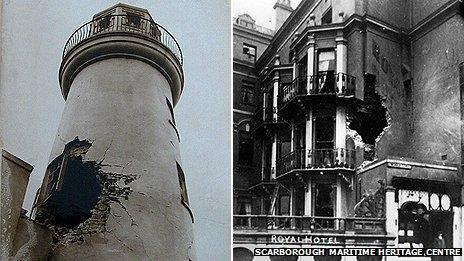
Scarborough landmarks like the lighthouse and Royal Hotel took direct hits

Such was the popular interest in the story, a brisk trade in souvenirs sprang up

Hartlepool took the brunt of the punishment with about 600 homes damaged
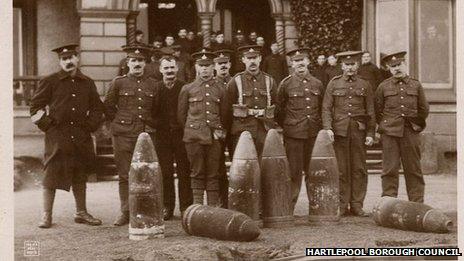
Many of the huge naval shells did not explode and were collected by the army
Hit squarely on the front, the house had partly collapsed.
Christopher and his father survived but his brother Albert, mother Johanna and two boys, George Barnes, 5, and John Ward, 10, had to be dug out of the rubble. All died soon afterwards.
Maritime historian Dr Robb Robinson says: "We think of the war, we think of it not just as the first world war but the first total war.
"Total war means that everyone, civilians and every aspect of the economy was involved and this was one dimension of that.
"No longer on this island were we as safe and secure as we expected."
More than 500 shells battered Scarborough.
At Gladstone Road School, children arriving early had to hide in the cellar. St Martin's Church, preparing for a wedding, lost part of its roof.
The Grand Hotel, town hall, lighthouse, castle and dozens of houses were badly damaged.
In about 30 minutes of shelling, 17 people died and many more were injured.
But Scarborough had escaped relatively lightly.
Just minutes later and 50 miles away, three other warships opened fire on Hartlepool.
'Waves of destruction'
With docks, factories and even a detachment of soldiers, the town was the bigger target.
Coastal guns mounted a defence and fired 123 shells, which damaged a ship, but the German broadsides poured 1,150 shells into the town.
"There was panic," says Mark Simmons, Hartlepool Museum manager. "Families loaded belongings on to carts and fled inland. Some workers smashed their way out of factories, which routinely locked them in.
"But for the Germans, this was no random assault. It seems they had a plan. Suppress the coastal batteries then move on to the docks. But of course shells go astray.
"You can see waves of destruction moving across residential areas of Hartlepool and West Hartlepool. Did they target civilians? It is difficult to know - but my feeling is they weren't worried about it."
New research suggests 114 civilians, nine soldiers and seven sailors were killed or fatally wounded.
Navy humiliated
At least 500 people were injured, with about 600 houses and dozens of factories damaged.
The carnage would have been greater but as many as a third of the shells, designed to be used at longer range, failed to explode.
Whitby was also shelled. Three people died and the famous abbey took a direct hit that left its western doorway wrecked.
The Germans had wanted to humiliate the Royal Navy and intimidate the British public.
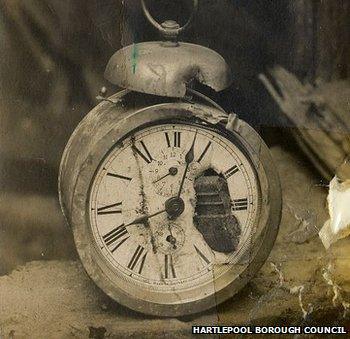
The iconic image of the attack was this (German made) clock which was stopped by a shell splinter
In the first of these objectives they succeeded - but the second spectacularly backfired.
Britain's navy was indeed lambasted for its failure to protect the towns.
Souvenir industry
Dr Robinson says: "For 10 years, the country had spent a fantastic amount of money on these dreadnought battleships.
"We were told we were secure, but suddenly the Germans have slipped in, bombarded three towns in the area and got away safely."
Rather than inspiring terror among the population, however, the raids provoked belligerent fury.
Nationally, "Remember Scarborough!" became a resounding rallying cry against the savagery of the Kaiser.
An image of Number 2 Wykeham Street was used in an enlistment poster that depicted a girl holding a baby standing outside the ruins of the house. The poster's slogan read: "Men of Britain! Will You Stand This?"
"The focus on Scarborough was because the papers played to their audiences," says Mr Simmons. "Hartlepool was a rough, industrial northern town, which had guns and troops.
"Scarborough was undefended and the sort of place people in the home counties might visit on holiday."
Life had to go on though, and with it businesses got back to work.
"Within days, there were adverts in the papers for coach tours of the damage," Mr Simmons adds.
"A small industry sprang up producing souvenirs, postcards and even fake iron crosses, complete with the names of Hartlepool, Whitby and Scarborough."
Warfare changed
But Hartlepool in particular, felt itself on the front line for the rest of the war.
Its population donated more money, per head, to war causes than any other in the British Empire.
The attack may even have helped British women play a far greater role in the war as nurses, munitions workers and ambulance drivers.
Writer and broadcaster Kate Adie explains: "The idea had been that women should never be put near (the dangers of battle), it was men who would shield them and protect them.
"Really, that idea disappeared in the first few months of the war when women in Hartlepool and Scarborough who found themselves victims of German shell fire.
"Women were moved, involuntarily, into a new kind of front line."
Hear how a devastated Scarborough house became a propaganda icon and find out more from Neil Oliver on the WW1 propaganda techniques still in use today.
- Published1 August 2013